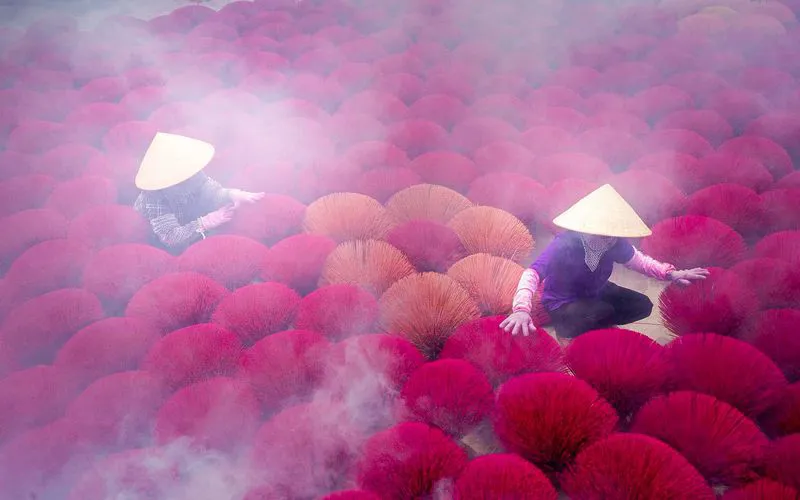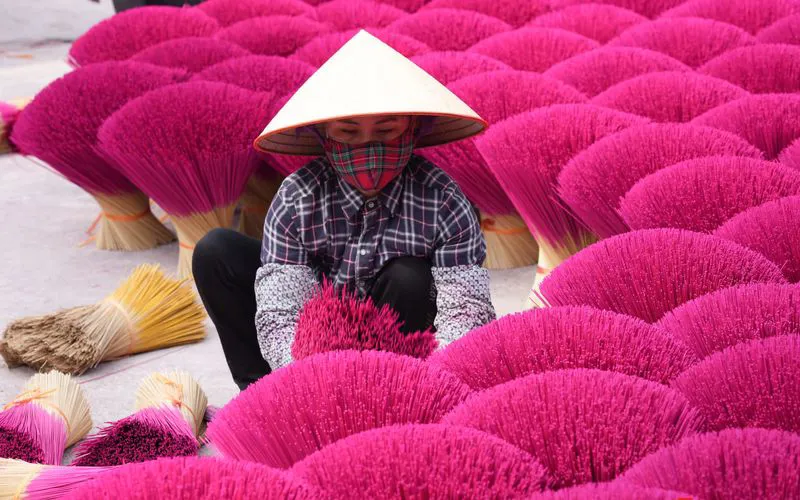Busy incense village after social distancing
The village’s products are not only consumed in Vietnam but also in India, China, Malaysia, and other countries.
Quang Phu Cau Village, a century-old village of incense making in Hanoi's suburban district of Ung Hoa, has resumed its business after nearly two months of social distancing.
The business disruption was due to the fourth coronavirus outbreak in late April that forced the capital city to apply strict social distancing measures.
Everywhere in Cau Bau, Phu Luong Thuong, and Dao Tu hamlets in Quang Phu Cau Village, the streets are filled with bunches of blazing red and pink incense sticks again.
“Since we had to close our workshop, the workers' daily income sharply decreased. Moreover, a dramatic drop in incense price also caused us serious hardship," Ly Thi En, an owner of an incense production facility in Cau Bau Ward of Quang Phu Cau Commune, told The Hanoi Times.
After two months of hiatus due to social distancing, incense craftsmen now return to work. Photo: Nam Nguyen |
"Currently, we are trying our best to gradually overcome difficulties to stabilize operations. Some customers have started ordering and making contracts. This is a really good sign and great encouragement for us,” En said.
Nguyen Huu Nhat, chairman of the People's Committee of Quang Phu Cau Commune, said that the commune has six villages all running incense business.
He stressed that villagers are seriously observing regulations on Covid-19 prevention and control, especially after the communal People's Committee announcement about the post-social distancing rules. All production households have actively set up plans to meet the requirements of the Ministry of Health.
"Although the communal authorities have loosened curbs on public movement and production activities after a long period of social distancing, it is necessary to encourage people to return to work while continue ensuring anti-pandemic rules," Nhat told The Hanoi Times.
Beginning as a part-time job, the craft now generates incomes to nearly 3,000 households, accounting for around 70% of the total households in the village.
Before the pandemic, each worker could earn between VND5-6 million (US$215-258) a month. Those who have more experience could make VND6-8 million (US$258-345).
A woman in Quang Phu Cau Village is drying bunches of incense sticks in the sun. Photo: Nam Nguyen |
The village’s products are consumed not only in Vietnam but also in India, China, Malaysia, and other countries. On average, Quang Phu Cau uses around 200 tons of materials a month and produces 50 tons of incense.
CNN has highlighted this century-old incense-making village in Hanoi by rating a snapshot of it as one of the best travel photographs in 2019. French news agency AFP run an article about the village on its news site in January this year when the village was entering its busiest season of the year.
Preserving traditional craft
According to local elders, the village has been a great source of incense supply for the northern region for many decades, and colorful photos of the village have become Vietnam tourism’s calling cards around the world. However, villagers are now struggling to preserve the more than 100-year-old craft, which they consider unique.
The production halt has significantly affected local business earnings, tax revenue, and jobs for workers in the village.
At the incense workshop of Nguyen Tien Thi, chairman of Thuy Xuan Tien Cooperative, eight people have returned to work after the social distancing rules were lifted.
"The production facility has committed to absolutely complying with the Ministry of Health's anti-pandemic rules. Before they start working, laborers are asked to fully observe Covid-19 countermeasures such as wearing masks, measuring body temperatures, and disinfecting hands," Thi told The Hanoi Times.
The commune located in the outlying district of Ung Hoa is covered with red, the color of incense sticks. Photo: @travelandleisureindia |
Although craft villagers have been happy as returning to work, restoring business activities is no easy task, especially for small-scale workshops which, after a long hiatus due to the pandemic, are left with very few resources to cover production costs and boost investment.
Before the Covid-19 outbreak, Quang Phu Cau village was awash with hundreds of brightly colored incense-stick bunches standing on the roadsides in the sun for drying. They flashed under the sunlight in astonishing glows of red, pink and brown.
Since the city eased social distancing rules, local authorities and villagers are excited to reopen businesses.
The village has more than 300 households engaged in the trade which is passed down through generations. In the run-up to Tet, the Lunar New Year holiday, Vietnam’s biggest and most important festival, the village was at its busiest because the entire population of the country lights incense at home and pagodas.
In an interview with The Hanoi Times, Chairman of Ung Hoa District People's Committee Pham Anh Tuan said since the villagers apply mechanization in production, incense output has sharply increased.
"People in Quang Phu Cau Commune believe that making incense has a spiritual meaning, so they are committed to producing the best incense. Through many ups and downs, the trade has brought a comfortable life to the locals. They are able to afford big houses and upgrade the village road system," Tuan said.













